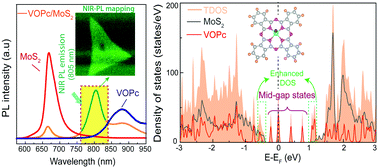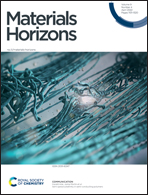Interlayer exciton emission in a MoS2/VOPc inorganic/organic van der Waals heterostructure†
Abstract
Heterostructures built from two-dimensional (2D) materials and organic semiconductors offer a unique platform for addressing many fundamental physics and construction of functional devices by taking advantage of both the 2D materials and organic semiconductors. We report interlayer exciton emission in the near infrared range around 1.54 eV (∼805 nm) from the heterostructure of pyramidal VOPc (p-type) and transition metal dichalcogenide monolayer MoS2 (VOPc/MoS2). This contrasts the observation of photoluminescence (PL) from the SnCl2Pc/MoS2 heterostructure despite both being type-II heterostructures. We attribute the exciton emission to the carrier transition from the generated interface mid-gap states of VOPc to the ground states of MoS2 in the heterostructure system as predicted from density functional theory (DFT) calculations. Furthermore, the observed PL signal of the VOPc/MoS2 heterostructure shows blue shift, while the PL peak of the SnCl2Pc/MoS2 heterostructure shows red shift. Our finding opens up a new avenue to tune the optoelectronic properties of the van der Waals heterojunctions consisting of 2D materials and organic semiconductors for optoelectronic applications.



 Please wait while we load your content...
Please wait while we load your content...